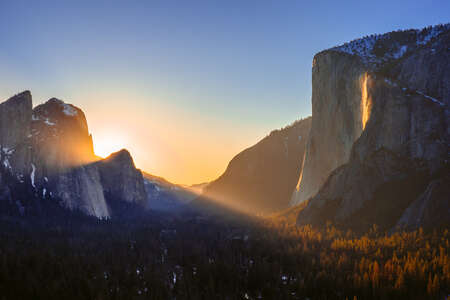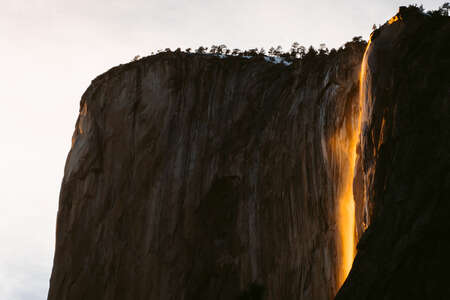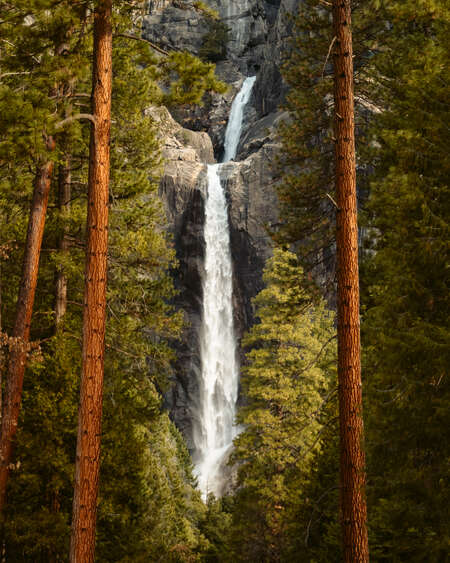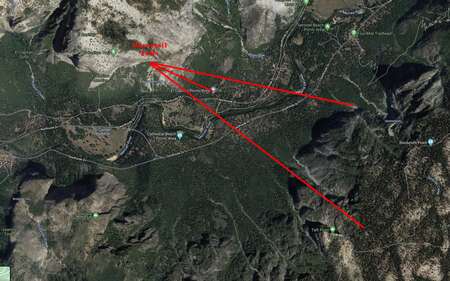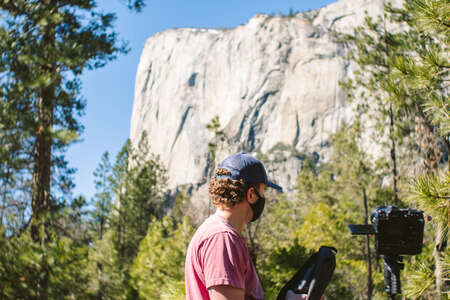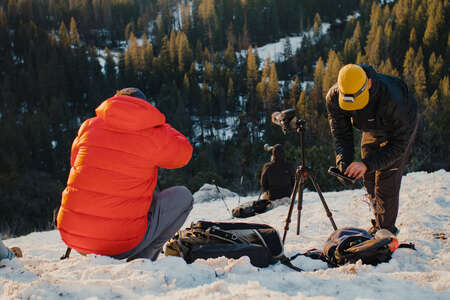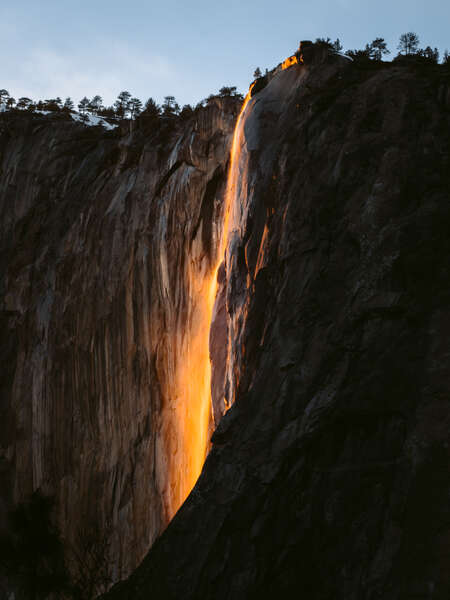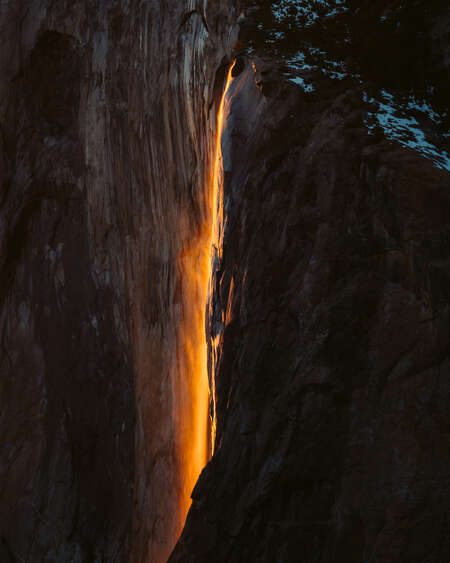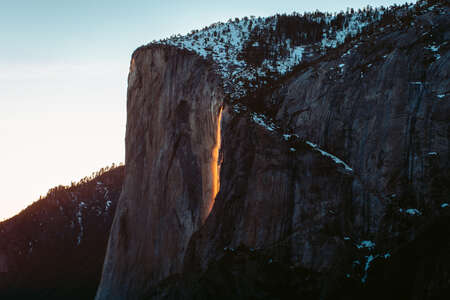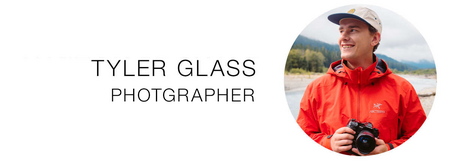Every year in the month of February, for just two weeks, a natural phenomenon happens in Yosemite National Park. The last few moments of sunlight hit Horsetail Falls for about 15 minutes each evening, giving the waterfall a glow that can only be described as to fire or lava. Each year, thousands flood into the valley to capture this rare and unique event.
In 2021, I finally got my chance to photograph it. Here is how you can too!
What is Firefall?
Originally, firefall was actually termed for the Glacier Point Lodge tossing coal embers or Glacier Point to create a lava-like waterfall once a year. Though this tradition stayed alive and well for almost 100 years, the National Park Service eventually scrapped the event.
Though the original firefall ended, a natural firefall would eventually take its place on the eastern wall of El Capitan. A seasonal waterfall called Horsetail Falls appears at the beginning of every February and lasts through the spring. For two weeks during that time, the sunlight hits at the perfect spot for the last 15 minutes of every sunset, hitting nothing else in the valley except for the waterfall. It is unsure how long this has been occurring, but was first documented in the 1970’s. In 2019, Firefall hit the mainstream media. Since then, thousands have flooded into the park to get their shot of the phenomenon.
Photographing Firefall
Weather Conditions
You will want to keep your schedule open from February 12th-27th. This is typically when firefall takes places, the peak usually being around the 21st. Also keep your eye on the weather as conditions will need to be just about perfect. The weather has to be just right for the event to happen. Yosemite has to have an average or above average winter.
In 2020, I was unable to capture the falls because there was literally no water to photograph. Weather was perfect, but there wasn't a waterfall to capture that entire year. Warm temperatures are a must to melt the snow in order for there to be water.
Most importantly, you need a clean line of sunlight to reach that valley wall. Clouds in the area will help fill your frame, but the horizon must be clear in order for the waterfall to glow.
Yosemite Restrictions
Beginning in 2021, the National Park Service announced that February park access would be by reservation only. Mostly due to COVID-19, the goal was to restrict access to too many visitors per day. It is unclear if this will continue in 2022, simply because the event is becoming more popular every year.
Visitors are also not allowed between the Merced River and Southside Drive between 12pm-7pm during the month of February, nor are pedestrians allowed on Southside Drive during that time period. It's another reason to arrive early because one of the viewing areas is off Southside Drive.
Best Spots to Photograph From
Before 2019, you could photograph the waterfall from just about anywhere in the park, with 4-5 recommended places. Since then, restrictions have been put into place to protect certain areas from destruction from having too much foot traffic. This brought the recommended viewing areas down to two (or three if you are willing to hike 25 miles).
El Capitan Picnic area is the most accessible, and incidentally the most crowded spot in the park to capture firefall. Located just east of El Capitan, you will need to park at the visitor center and walk 1.5 miles down Northside Drive to get a spot.
We arrived over six hours early just to make sure we got the exact perspective we wanted. If we had arrived even 30 minutes later, we wouldn’t have had that spot. That’s just how crazy packed this event gets. This area gives you a close up look at the waterfall as you will be just below it.
The second viewing area I recommend is off of the valley loop trail. Park at or near the Swinging Bridge parking lot and walk about half a mile west on the valley loop trail. On the left will be two rock shoots, both of which provide great perspectives of Horsetail Falls. These hikes are short, but can be strenuous or covered in snow and ice so make sure to bring Yaktrax and/or snowshoes. Though these hikes can be a bit more difficult, they give you a unique perspective and are typically far less crowded than the El Capitan picnic area. More often than not, there may only be a handful of people in more secluded spots. This spot offers you a wider look at firefall and the entire valley before you.
The third option for viewing is a much more intense and strenuous hike – the south rim of the valley. You will need to hike Glacier Point Road from Badger pass, a mere 25 miles roundtrip. The road is normally covered in snow so you will also need either snowshoes or skis, as well as winter hiking experience. This area has been rarely photographed during firefalls. This is not for the novice hiker. Pop-up storms in Yosemite are common in the winter and can be dangerous to the most experienced of hikers.
What Gear Should I Bring?
Gear is always an important topic when it comes to shooting something that only lasts 15 minutes. It can be hard to figure out what focal length you need, if you will need a neutral density or polarizer filter, etc. This is just another reason to arrive early so you can experiment with different lenses and attachments well in advance. That being said, these were my go-to lenses, bodies and accessories during my time in Yosemite.
I photographed each shoot with the OM-D E-M1 Mark III along with the M.Zuiko 12-100mm F4.0 IS PRO. I used this lens simply because of how versatile it is. I was able to shoot both wide and tight in a matter of seconds, without having to change the lens throughout that 15 minute time period. It is important that you take advantage of every moment during that 15 minutes because it does go by fast.
I had a secondary camera setup for an interval time lapse every night that I shot the falls. I used the OM-D E-M1X with the M.Zuiko 40-150mm F2.8 PRO. Though this is another versatile lens, I mainly stayed pretty tight on the waterfall for my timelapses. If I was too wide, you couldn’t really see the movement of the waterfall so it looked more like a photo than a timelapse.
Recommended Settings & Tips
When shooting Horsetail Falls, I began by putting my aperture at F22 and then adjusted my shutter speed as the evening went on. I of course kept my ISO at 64 the entire week. I usually keep my white balance at an even 6,000, which helps give the falls a nice warm glow.
Though it isn’t necessary, I HIGHLY recommend using a tripod. Anyone who knows me knows that I do not like using tripods and avoid them whenever I can. But in this case, I wanted to keep my aperture as narrow as possible to open up my shutter to show the flow of the water. I brought two tripods with me. One for photos and the other for the time lapses.
Shooting firefall just one day may not be enough. Plan on staying at least two nights, that way if conditions don’t line up on the first night, you also have at least one more shot at it the next day.
Bring snow chains, snowshoes, micro spikes and enough warm clothes to prepare for any winter popup storms. They are not uncommon on Yosemite and can be treacherous. Also bring plenty of food. You may be sitting in one spot for hours. We brought sandwiches, soup in a thermos and granola.
The best period of light happens between 5:28pm and 5:40pm. You will have 12-15 minutes to shoot, so don’t feel too rushed once it begins. Just experiment with your settings and be confident.
Take a break. If at one point, you feel that you’ve got the shots you need, step back from the camera and really experiment with the falls. This moment only happens once a year, in one exact spot on the entire planet and you are going to be witnessing it. Don’t let the entire experience happen through an LCD screen. Be in that moment and have fun!
Instagram: @tylerwayneglass
Tyler is a photographer and writer, born and raised in Louisville, Kentucky. His ultimate goal in being a creative is to inspire others through his images, and to care more for the beautiful planet that we inhabit.
